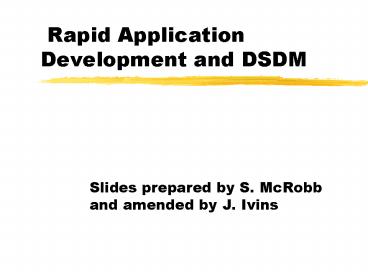Rapid Application Development and DSDM - PowerPoint PPT Presentation
1 / 22
Title:
Rapid Application Development and DSDM
Description:
This lecture looks at an industry-standard design methodology that ... Often little more than hype ( e.g. RAD = use of VB ) Dynamic System Development Method ... – PowerPoint PPT presentation
Number of Views:244
Avg rating:3.0/5.0
Title: Rapid Application Development and DSDM
1
Rapid Application Development and DSDM
- Slides prepared by S. McRobb and amended by J.
Ivins
2
Overview of lecture
- This lecture looks at an industry-standard design
methodology that continues the idea of
participative design PD - The model incorporates a lifecycle model and
explicitly requires user involvement in the
design process
3
Background
- The emergence of RAD
- DSDM - a methodology for RAD
- The 9 Principles of DSDM
- Critical success factors for RAD projects
- The RAD team
- NB DSDM and RAD were developed by software
engineers
4
Drivers for RAD
- Sources of frustration / uncertainty
- Business drivers
- Development process drivers
- Examples
- frustration with project timescales
- problems with early requirements freeze
- continued poor involvement of users
- some elements of RAD were already familiar
5
Early days of RAD
- Reactive
- Fragmented
- Often little more than hype
- ( e.g. RAD use of VB )
6
Dynamic System Development Method
- Standard RAD method since 1994
- A Software Engineering Standard
- Industry-wide Consortium
- IBM, ICL, LBMS, British Airways, etc.
- Mission-
- develop and continuously evolve a public domain
method for RAD
7
DSDM
- 5 phases-
- feasibility
- business study
- functional prototype iteration
- design prototype iteration
- implementation
- Can we apply to multimedia production?
8
Project Selection
- appropriate projects have
- functionality that is visible at the user
interface - all users clearly identified
- limited computational complexity
- if large, can be easily split into increments
- a real time-constraint
- flexibility in the detailed requirements
9
DSDM
Lifecycle Model
Feasibility
Business Study
Implementation
Functional model
Design build
10
DSDM9 Principles
- active user involvement
- teams are empowered
- focus on frequent product delivery
- fitness for business purpose is the essential
criterion for acceptance - iterative and incremental development
11
9 Principles (continued)
- reversibility of all changes
- requirements baselined at high level
- testing integrated throughout life-cycle
- collaborative and cooperative approach
12
Timeboxing
- absolute time frame for a deliverable
- product-, not activity-based
- unfinished products delivered on time
- deliver what you can.
- . but it must work !
13
Timebox
- Can apply to
- whole project
- single component
- Focuses minds on delivery
- Improves manager client confidence
- Built into project schedule very early
- Not ( usually ) changed later
14
Timebox planning advice
- Short (2-6 weeks optimal)
- Prioritise requirements with MoSCoW
- Must have...
- Should have...
- Could have...
- Want to have...
15
Timebox planning advice
checkpoints
C
O
O
C
C
O
refine
consolidate
investigate
set objectives
16
Managers role
- A logistical challenge
- Move from analysis to design very fast
- No room for slip
- All facilities must be ready when needed
- Little emphasis on change control
- scope controlled by plan and timeboxes
- within timebox, changes are made as easy as
practicable
17
Managers role
- Project contingency
- .is accounted for by MoSCoW rating of
requirements - .thus no contingency in schedule
- Gantt chart usually of little use
- You know where the project has got to by a given
date!
18
Project communications
- Typically short sharp daily meetings (30 mins
maximum) - Focus on delivery, not activity
- BA rule no-one is allowed to say
- I am doing
- Can only say
- I have done...
19
Organisation impact
- Significant culture change
- Education training required
- Project Board workload may increase immensely
- Approval stage much more important, as less
opportunity to halt / refocus later
20
Summary
- This topic has covered
- Reasons for RAD
- Principles of DSDM
- Implications of DSDM for
- manager
- teams
- organisation
21
Summary continued
- Three models have been introduced in Lecture 3 a
b. - Each has strengths and weaknesses
- DSDM appears to offer a model and a methodology
which can be applied to multimedia design.
22
Reading
- Stapleton J (1997), DSDM, Addison-Wesley (covers
V2). - DSDM Consortium at-
- www.dsdm.org































